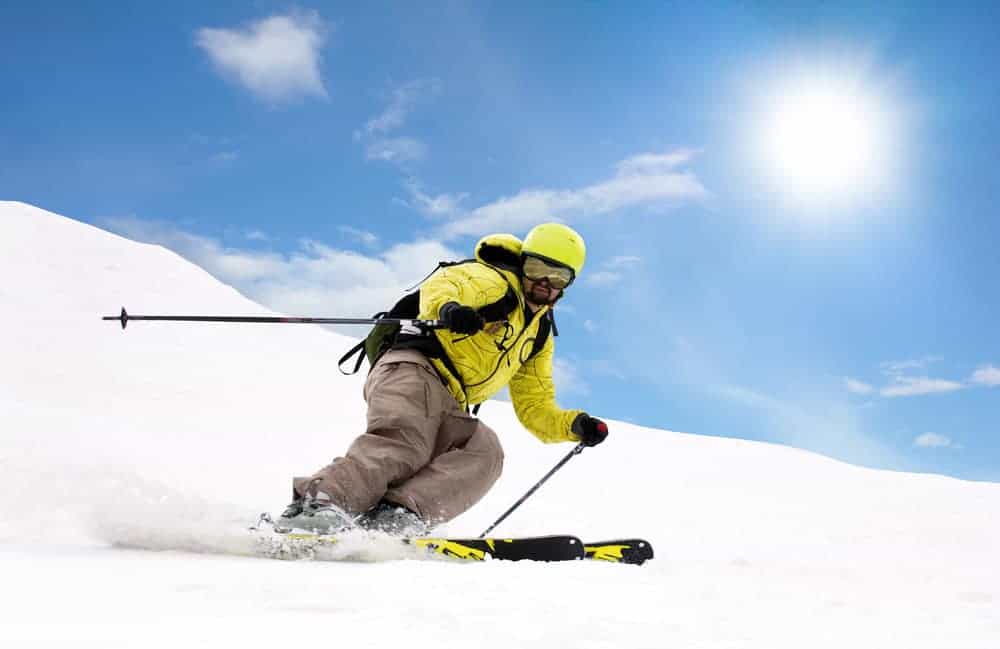Choosing a ski goggle lens color may seem as simple as selecting the color that you like best or that matches the rest of your gear.
It is not that simple, however.
Each lens color has a specific area of expertise. For example, a yellow lens is best for low light conditions, and a blue lens is best for bright conditions. It can be tricky to know what color to use. Have no fear; we’ll get into the different colors in more detail below.
When choosing a ski goggle color, several factors come into play, including the weather, time of the day, and terrain.
Before you can determine which color is right for you, think about your usual skiing circumstances: Is the mountain bathed in the sun in the mornings, afternoons, or throughout the day? Do you usually ski on smooth trails or areas with trees and moguls?

When selecting the right color for your ski goggle, your objective is to find a tint that provides a combination of the following:
- Depth perception,
- Eye fatigue protection,
- Color definition, and
- Contrast.
In this ski goggle lens color guide, we will be taking a look at general buying considerations such as frame types, comfort, and helmet compatibility. We will also discuss the characteristics of the different lens colors and how you should go about choosing one that’s right for you.
Different Types of Frames and Helmet Compatibility
Vents
A ski goggle frame should have sufficient venting to allow for airflow through the goggles while you’re wearing them. If your goggles aren’t fitted with enough vents, you’ll have difficulty with fogging, sweat, and heat.
Helmet Compatibility
If you wear a helmet, the goggles you purchase should fit the helmet. To make sure that this the case, take the helmet with you when you go shopping for goggles and, before trying on your goggles, put on the helmet so that it sits comfortably on your head.
A pair of goggles that fits your helmet will:
- Not have a “gaper gap” that exposes your forehead between the top of the
goggle and the rim of the helmet,
- Not push down on your nose and make breathing difficult, and
- Fit comfortably around your entire face.
Padding
Ski goggle padding consists of foam layers to increase comfort. These foam layers typically have a limited lifespan, so find a goggle with high-quality padding.
Anti-Fogging
Goggles with sufficient ventilation and dual lenses usually don’t fog up easily. There are, however, several things you can do to eliminate the frustration and dangers associated with fogging, including:
- Keeping snow off the vents,
- Shaking moisture out of your lens and air drying it instead of rubbing it dry,
- Not putting your goggles on your forehead, and – Buying a goggle that fits your face to improve air circulation.

Lens Colors and Which to Choose
Visual Light Transmission – VLT
When it comes to selecting the right color lens, the first consideration is Visual Light Transmission (VLT) which is a percentage indication of the amount of light that the lens allows through.
Flat or Curved Lenses?
Flat or cylindrical lenses have a lower profile than curved or spherical lenses, which curve both vertically and horizontally.
Curved lenses with their “bubbled” appearance typically provide better peripheral vision than flatter lenses. A curved lens usually also does a better job at reducing glare and lens distortion than a flat lens.
The benefit of flat lenses is that they typically fall in a lower price range than curved glasses.
Which Lens Colors Work Best for Different Conditions?
Clear Lenses (VLT: 82%)
Clear ski goggles are ideal for night skiing and low-light conditions, and their only purpose is to protect your eyes from flying particles or dust. Try to find clear lenses with UV protection.
Pink/Rose Lenses (VLT: 62%)
Pink or rose-colored lenses are suitable for conditions when there is no sunlight. These conditions include overcast days, and dusk or dawn.
Yellow Lenses (VLT: 73%)
Yellow lenses enhance environmental detail, and their VLT allows for skiing in sunny and low-light conditions alike. A yellow lens is the most versatile option for people who like to ski in many different circumstances.
Orange or Amber Lenses (VLT: 51%)
Orange and amber-colored lenses are suitable for overcast and sunny conditions that are not too bright. Orange lenses have the added benefit that they increase visual ability in foggy conditions.
Gold Lenses (VLT: 16%)
Lenses that have a gold or bronze color are suitable for bright and sunny conditions, and they feature excellent depth perception and contrast. Try to find lenses that are polarized to help reduce glare from the snow.
Gold lenses are not suitable for overcast or low-light conditions.
Red Lenses (VLT: 20%)
Red lenses are suitable for skiing in medium to bright light conditions. They also enhance color definition and depth perception.
Green Lenses (VLT: 19%)
Like yellow lenses, green lenses are also suitable for a wide range of skiing conditions. Also, they reduce eye fatigue from glare and improve color definition in overcast conditions.
Blue Lenses (VLT: 4%)
Blue lenses are geared towards cutting glare in “bluebird” conditions, especially when you use them in combination with a bronze-based tint.
Black Lenses (VLT: 3%)
Black lenses are only suitable for sunny, bright light conditions and are ideal for reducing glare and eye fatigue.
Conclusion
Lens color for ski goggle is only one buying consideration, but it is one of the most significant ones. To find out which ski goggle lens color is best for you, consider the skiing conditions that you prefer and that you encounter on a regular basis.
If you don’t regularly ski in extreme conditions, or if you don’t want to purchase a lens for every possible condition, you may be better off with a versatile yellow, green, or red lens. In addition to the right color, find a ski goggle that is comfortable and that fits your helmet. The goggles should also provide sufficient ventilation to enhance airflow and prevent fogging.
